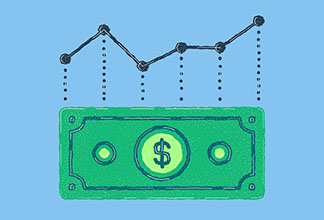Preparing for Retirement? Focus on Tax Efficiency
Published on August 17, 2020
minute read
Share:
The final years leading up to retirement represent the “home stretch” of your retirement savings strategy. These are also likely to be your peak earning years, as you near the top of your career path.
But higher earnings attract higher tax rates. If your children are self-sufficient and your home is almost or completely paid off, income taxes are likely to be one of your largest expenses. By paying as little tax as necessary, however, you may be able to increase your after-tax cash flow. The money that doesn’t go to the government can be redirected to your retirement savings.
Take a portfolio approach
With investing, it’s always important to take a portfolio approach.
This means you need to look at all the investments — both registered (RRSP, TFSA for example) and non-registered — held by you and your spouse, if applicable, as one integrated “portfolio.” By examining the big picture you can arrange your investments to be as tax-efficient as possible.
Let’s start with the types of investment income earned within your portfolio. Each is subject to a different tax treatment. Here are the four most common types:
- Interest income: Payments received for lending funds to a borrower are taxable at your marginal rate — the tax rate that applies to the top tier of your employment income under Canada’s graduated-tax system. This includes interest earned from bank accounts, guaranteed investment certificates (GICs), bonds and fixed income mutual funds, exchange-traded funds and all other interest-producing investments.
- Capital gains: Profits from the sale of property or investments are taxable only when realized — that is, when you sell or transfer the property. Only 50% of the increase over what you originally paid is taxable at your marginal rate.
Profits from the sale of property or investments are taxable only when realized
- Dividends from Canadian corporations: Payments to shareholders, usually as a share of the company profits. A dividend can be designated as non-eligible or eligible. Dividends qualify for the dividend tax credit, which reduces your total tax due. Eligible dividends qualify for an enhanced tax credit. The precise effect will vary according to your overall income and province of residence.
- Dividends from foreign corporations: Dividend distributions from non-Canadian corporations are subject to a different tax treatment. They are fully taxable at your marginal rate and do not qualify for a dividend tax credit. In addition, in most cases there will also be withholding taxes paid to the foreign country, the amount depending on the country, the type of investment product and type of account holding the shares. A foreign tax credit may be available and could reduce the tax payable in Canada on the dividend. Other particularities may apply and it is best to consult with a tax professional to fully understand tax implications of any foreign dividends you receive.
- Return of capital: When an investment pays a regular distribution, but the interest, dividends and realized capital gains are less than the fixed distribution amount, the difference is considered return of capital to its investors. This is not considered income and is not taxed in the year it’s received. Instead, it is subtracted from the price you originally paid for the fund, resulting in a larger capital gain when you eventually sell or transfer it.
Maximizing RRSPs
To have more money in retirement and pay less tax now, you may want to contribute as much as you can to your Registered Retirement Savings Plan (RRSP). Here are some ways to achieve that:
- Once you have used up your annual contribution room, fill any deduction room carried forward from previous years when you didn’t make your maximum contribution.
- Consider automating your contributions by setting up a pre-authorized contribution. You contribute on a regular basis over the year – weekly, bi-weekly, monthly or quarterly – instead of a lump sum.
- Tax refunds and company bonuses can also help you fill unused contribution room.
- Consider starting or adding to a spousal plan. A spousal plan is useful if your spouse has little set aside for retirement and does not expect a significant pension or other retirement income. Contributing to a spousal RRSP while you’re still working can help equalize your retirement savings as a couple. This will make your retirement incomes more equal, which can lower your overall household income tax in retirement.
Consider automating your contributions by setting up a pre-authorized contribution. You contribute on a regular basis over the year.
Remember the Tax-Free Savings Account (TFSA)
You can also save in a TFSA. While contributions are not tax-deductible, your investments will grow tax-sheltered and will not be taxed on withdrawal. Plus, unlike an RRSP, you do not have to collapse your TFSA when you reach a certain age and contribution room does not depend on your income.
Minimize tax on non-registered investments
By coordinating your registered and non-registered portfolios, you may be able to reduce your overall tax liability.
Maintain tax deferral with a Registered Retirement Income Fund (RRIF)
When you collapse your RRSP, you can continue to benefit from tax-deferred growth by rolling the assets into a RRIF. While you must withdraw a certain amount from the RRIF each year, amounts remaining in the plan are tax-deferred.
You may need to adjust your RRSP portfolio when this roll-over occurs, shifting from an emphasis on growth and capital preservation to a strategy aimed at growth and income.
Holding investments that generate fully taxable interest income in your RRSP or RRIF allows them to grow in a tax-sheltered environment. Meanwhile, holding equities and equity mutual funds in your non-registered accounts allows you to benefit fully from the Canadian dividend tax credit and the preferential tax treatment for capital gains.
The tax implications of investment income should never be the main factor in an investment decision. Your portfolio should be structured for your time horizon, liquidity needs and risk tolerance. But within those guidelines, paying attention to tax implications can help you reduce your tax bill, so there’s more left for you to invest and enjoy in retirement.
The information provided in this article is for general purposes only and does not constitute personal financial advice. Please consult with your own professional advisor to discuss your specific financial and tax needs.
RBC Direct Investing Inc. and Royal Bank of Canada are separate corporate entities which are affiliated. RBC Direct Investing Inc. is a wholly owned subsidiary of Royal Bank of Canada and is a Member of the Canadian Investment Regulatory Organization and the Canadian Investor Protection Fund. Royal Bank of Canada and certain of its issuers are related to RBC Direct Investing Inc. RBC Direct Investing Inc. does not provide investment advice or recommendations regarding the purchase or sale of any securities. Investors are responsible for their own investment decisions. RBC Direct Investing is a business name used by RBC Direct Investing Inc. ® / ™ Trademark(s) of Royal Bank of Canada. RBC and Royal Bank are registered trademarks of Royal Bank of Canada. Used under licence.
© Royal Bank of Canada 2025.
Any information, opinions or views provided in this document, including hyperlinks to the RBC Direct Investing Inc. website or the websites of its affiliates or third parties, are for your general information only, and are not intended to provide legal, investment, financial, accounting, tax or other professional advice. While information presented is believed to be factual and current, its accuracy is not guaranteed and it should not be regarded as a complete analysis of the subjects discussed. All expressions of opinion reflect the judgment of the author(s) as of the date of publication and are subject to change. No endorsement of any third parties or their advice, opinions, information, products or services is expressly given or implied by RBC Direct Investing Inc. or its affiliates. You should consult with your advisor before taking any action based upon the information contained in this document.
Furthermore, the products, services and securities referred to in this publication are only available in Canada and other jurisdictions where they may be legally offered for sale. Information available on the RBC Direct Investing website is intended for access by residents of Canada only, and should not be accessed from any jurisdiction outside Canada.
Inspired Investor brings you personal stories, timely information and expert insights to empower your investment decisions. Visit About Us to find out more.










